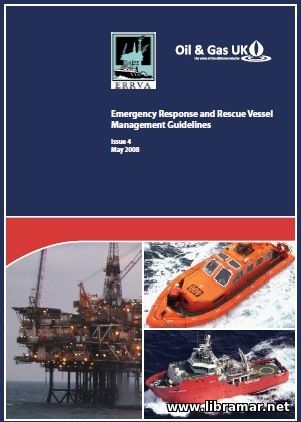 The present guidebook has been intended to provide the crew members and Masters of the EERVs, standing for the "emergency response and rescue vessels", as well as the OIMs, i.e. offshore installation managers and all other personnel involved in the offshore operations, with the general technical guidance regarding the proper conduct of those operations as part of the recovery arrangements.
This publication opens with the list of references and acronyms, explanation of terms and definitions that are used there throughout the document, general introductory information and guidance, followed by the information on routine operations - mobilization to location, operations on locations, verification and validation of recovery and rescue arrangements, procedures to follow when departing from location, emergency response and environmental emergencies, data cards, emergency response plans for offshore emergency and also escape or evacuation, typical installation checklist, example of the collision avoidance strategy, STS (ship-to-ship) transfer of crew by using rescue craft masters checklist, some established trial procedures for validation of the ERRV baseline performance, adverse weather standards, overside working and flying operations, baseline standards for recovery and rescue, place of safety and sample emergency scenario checklist, helicopter winching procedures, infringement of the safety zone forms, recovery and rescue support sharing methodology, and the use of non-certificated ERRV.
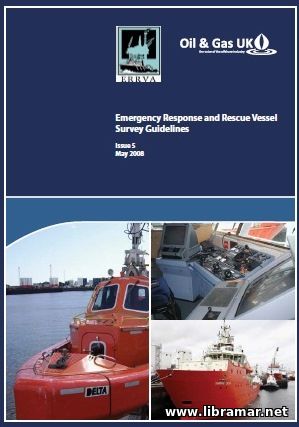 These valuable guidelines were prepared and officially released by the ERRVA together with the OGUK in order to provide the participants of the offshore industry with the necessary technical guidance to all operators and charterers of the ERRVs and marine surveyors to help them better assess the suitability of the vessels of the above mentioned type, servicing the offshore rigs, platforms and other installations and providing the required arrangements for the most effective response and recovery by offshore HSE legislation.
They were worked out following the extensive consultation with the MCA, HSE and a group of professionals and other interested parties. They describe what is commonly treated as a good offshore industry practice and recognized standards in order to enable the ship to carry out their fundamental functions of the offshore standby. It shall be noted that the provisions outlined in the present document are not considered mandatory, and the vessel operators are free to adopt different recognized standards in particular situations where following these recommendations will provide at least the equivalent or better safety level.
Among the topics covered in the document there are the certification process, stability, design and construction criteria, accommodation and various facilities for survived people, ERRV equipment, radio communications and others.
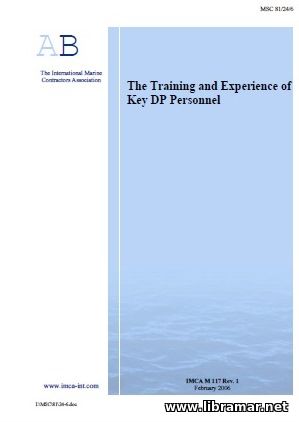 This volume was prepared and officially released by IMCA in order to reflect the recognized international maritime industry standard addressing the training, competence as well as professional experience that is required to be possessed by all key personnel involved in DP, i.e. dynamic positioning, operations on the vessel equipped with the DPS.
The document has been designed for ships that are engaged in marine operations where the accidental loss of position might easily result in loss of human life, severe pollution to the marine environment, major structural damage to the vessel, and economic loss. The DP operators are requested to attend the formal training courses and also gain necessary practical experience; in addition to what is stated above, they should all meet the associated certification requirements. This publication is also providing some guidance relating to the structural familiarization procedure for the above mentioned personnel joining a vessel with DP system, or starting a new project.
Moreover, it also provides associated practices as well as principles for refresher training. In short, the book will give the useful guidance for assurance of the professional competence as well as assessment requirements in the maritime industry. Would suggest a copy of the booklet is kept on board of any DP vessel.
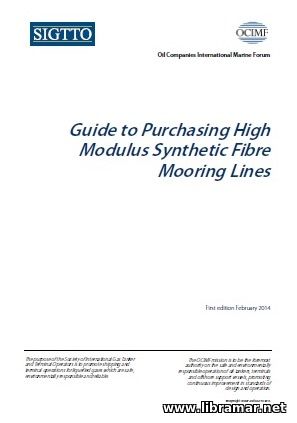 The intention which has declared by the authors of the present technical document was to give the necessary professional guidance to all people directly involved in the ordering of the HMSF, standing for the high modulus synthetic fiber mooring lines, including the lines that are fabricated from Aramid, LCO and HMPE fibers. The aim is to ensure the due understanding of the particular mechanical properties of these mooring lines, encouraging the processes of adoption of improved technical specifications and quality assurance.
We would like to underline that the recognized international standards are there for the construction of the HMPE lines; however, the standards relating to Aramid and LCP fibers are limited. That is the main reason why the information contained in the present publication would definitely be of great practical use to people considering various ordering options.
The MHSF lines are considered as a good alternative to the traditional mooring lines that are usually made of the steel wires, due to their mechanical properties, particularly strength-to-weight, as well as the other advantages, for example the ease of handling. After several years of nearly incident-free use of the HMSF lines, the shipping industry has experiences a number of failures, particularly on large LNG carriers...
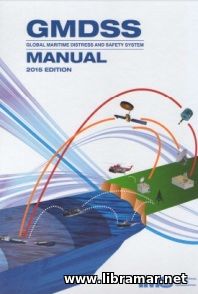 Please have a look in the publication offered here - the GMDSS Manual is intended to provide, in a single volume, a truly comprehensive explanation of all fundamental principles upon which the whole GMDSS system is based, together with the requirements that normally apply to the radio communications as well as relevant technical recommendations for the implementation and the standards for the operational performance of the associated equipment, it's required technical specifications, established procedures to follow etc.
The book features a remarkably detailed description of the concepts of GMDSS systems and their development, addressing also the system components, requirements for the carriage, supporting IMO resolutions plus other regulatory documentation; in addition to that, this document contains all relevant excerpts from SOLAS, ITU-R recommendations and relevant performance standards that have been developed by the IMO, NAVTEX and SafetyNET manuals, GMDSS Master Plan and wealth of other valuable information.
The publication has been released to be used by ship masters and personnel involved in radio communications, shore personnel, operators and trainers, marine authorities and regulators and in fact anyone interested. Note that this is the official 2015 edition of the Manual; please also note that the document shall not be treated as a substitution for the ITU Manual or any other mandatory publication...
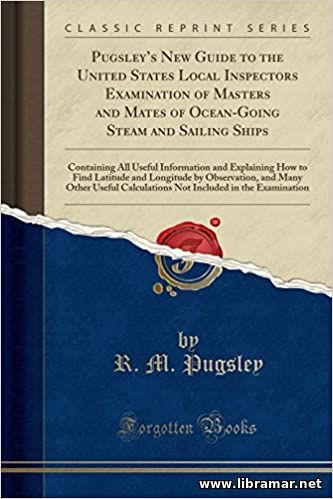 This classic and historically valuable publication is not only the official and complete guidebook for the US Examination of Masters & Mates, a full treatise on marine navigation, law of storms and astronomy, but also a nice textbook to be used by the students and practicing marine navigators as a reference tool. The volume contains the complete list of questions that used to be given by the examiners, making it a good preparation book for the subject exams.
The publication covers the whole range of problems and every single requirement for those applying for the license on either steam or sail ships. Needless to say that even though the book is not in a wide use in the maritime shipping industry of today, it should still be interesting to the people fond of the ships of the past times.
Written by the recognized professional mariner with great seagoing experience, this publication will be useful for those willing to understand the concept of the ocean-going an sailing vessels, including explanations on the main navigation principles, associated calculations and so many other relevant areas that should be well known and understandable to anyone willing to work on board subject vessels.
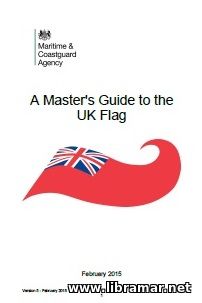 This guide book has been specifically prepared and released for the ship managers and masters plus senior ship officers working on the vessels registered in UK. The principal intention of the authors who have compiled the book was to provide above mentioned persons with the easy-to-use info connected with the existing UK Merchant Shipping regulations together with the all relevant administrative procedures.
These procedures and regulations might be significantly differing from ones the readers are familiar with and applicable to the ships flying other flags and the intention of this document is to guide the reader to compliance with the UK requirements. The current release of this guidebook was updated to be brought in line with the MLC coming into force. Twelve sections of the publication address the ship manning and applicable STCW requirements, hours of rest/work, crew lists, employment agreements, log books including GMDSS, health and safety matters, proper reporting of the accidents, requirements applied to the medical stores, surveys and audits, refugees, stowaways, alcohol, cadet training, CSR, i.e. continuous synopsis record, and a full list of UK publications that shall be possessed onboard. The annexes provide informative example of how exactly the RAF, i.e. risk assessment form, should be completed, and the MSF 4605...
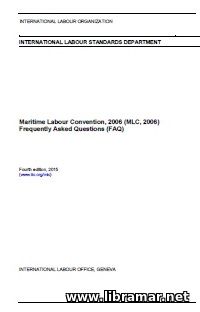 The fourth release of the FAQ to the ILO MLC, 2006 - worked out by the International Labor Office to serve as an integral part of the follow-up to the Action Plan. The MLC was officially adopted by the ninety-fourth session of the ILC in 2006, entered into force in 2013 and ratified by sixty-six countries having more than eighty percent of the world's GT of ships by 2015.
Please note that the answers that have been provided in the present publication shall not be cited as the legal opinions as the precise requirements of the MLC are there in the national laws/regulations. These answers are provided with the intention to give readers the required information in the form of concise and clear explanations that would refer to the MLC together with any other reference materials.
They shall not be considered legal advice. Literally every aspect is covered, including general in for about the MLC, questions about the people working on board the ships, questions related to the titles of the Convention, including minimum age, medical certification, training, qualification, recruitment, placement, conditions of employment, wages, hours of work/rest, leave, repatriation, manning levels, career development and so many other important issues.
« 1 2 ... 13 14 15 16 17 ... 24 25 » |







